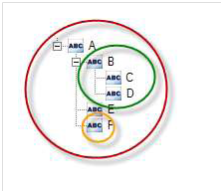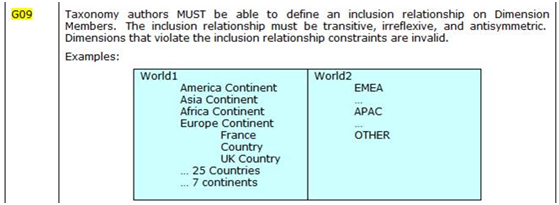Issued: July 26, 2013
Initially issued October 28, 2011
Impact: All US GAAP
This guidance is archived.
Issue
As companies represent detailed segment information, we have identified varying methods for representing segments and sub-segments.
There are two different approaches we have seen used to model this data.
- Create business sub-segments as children of the larger segment.
- Create a secondary dimension for the sub-segments.
Both these methods allow the sub-segment components of a segment to be described. One uses relationships and the other uses dimensions.
Approach 1 - Create business sub-segments as children of the larger segment
Having all business segments on one axis StatementBusinessSegmentsAxis ensures that users of XBRL data can identify what are actual business segments. It also precludes the need to create a duplicated business segment axis. This approach requires that the sub-segments are children of the larger segment. This parent-child relationship should be defined in the definition linkbase. The relationship used to define these children is the domain-member relationship[1].
Figure 18. Example of a nested dimension

Approach 2 - Create a secondary dimension for the sub-segments
This approach adds a second extension axis to represent business sub-segments. Using this method, dimensions are used to indicate that the sub-segment intersects with one parent segment. However, a sub-segment will never intersect with more than one parent segment. Adding a second axis means a user of the data cannot determine which of those items are sub-segments and those that are parent segments unless they interrogate the data facts. Secondly, the new extended sub-segment axis creates a second business segment axis. If a user tries to determine company segments by reading the members on the business segment axis, they will not be able to detect those business segments on the extension axis. Segments and sub-segments are not orthogonal to one another.
Aggregation
Neither approach indicates that the dimensional members can be aggregated to create a total or that they are a complete list of all the segments.
Recommendation
The segmental reporting note should follow the segmental reporting guidance published by FASB.
[1] The XBRL specification states “Inclusion relationships (requirement G09 [DIM-REQ]) are represented by domain‑member relationships.”






